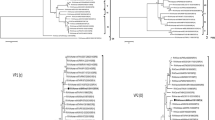Abstract
In this study, we determined the sequence of the coding region of an avian bornavirus detected in a blue-and-yellow macaw (Ara ararauna) with pathological/histopathological changes characteristic of proventricular dilatation disease. The genomic organization of the macaw bornavirus is similar to that of other bornaviruses, and its nucleotide sequence is nearly identical to the available partial parrot bornavirus 5 (PaBV-5) sequences. Phylogenetic analysis showed that these strains formed a monophyletic group distinct from other mammalian and avian bornaviruses and in calculations performed with matrix protein coding sequences, the PaBV-5 and PaBV-6 genotypes formed a common cluster, suggesting that according to the recently accepted classification system for bornaviruses, these two genotypes may belong to a new species, provisionally named Psittaciform 2 bornavirus.


Similar content being viewed by others
References
Adams MJ, Lefkowitz EJ, King AMQ, Bamford DH, Breitbart M, Davison AJ, Ghabrial SA, Gorbalenya AE, Knowles NJ, Krell P, Lavigne R, Prangishvili D, Sanfaçon H, Siddell SG, Simmonds P, Carstens EB (2015) Ratification vote on taxonomic proposals to the International Committee on Taxonomy of Viruses (2015). Arch Virol 160:1837–1850. doi:10.1007/s00705-015-2425-z
Altschul SF, Gish W, Miller W, Myers EW, Lipman DJ (1990) Basic local alignment search tool. J Mol Biol 215:403–410
Cubitt B, Oldstone C, de la Torre JC (1994) Sequence and genome organization of borna disease virus. J Virol 68:1382–1396
Honda T, Tomonaga K (2013) Nucleocytoplasmic shuttling of viral proteins in borna disease virus infection. Viruses 5:1978–1990. doi:10.3390/v5081978
Honkavuori KS, Shivaprasad HL, Williams BL, Quan PL, Hornig M, Street C, Palacios G, Hutchison SK, Franca M, Egholm M, Briese T, Lipkin WI (2008) Novel borna virus in psittacine birds with proventricular dilatation disease. Emerg Infect Dis 14:1883–1886. doi:10.3201/eid1412.080984
Horie M, Ueda K, Ueda A, Honda T, Tomonaga K (2012) Detection of avian bornavirus 5 RNA in Eclectus roratus with feather picking disorder. Microbiol Immunol 56:346–349. doi:10.1111/j.1348-0421.2012.00436.x
Kistler AL, Gancz A, Clubb S, Skewes-Cox P, Fischer K, Sorber K, Chiu CY, Lublin A, Mechani S, Farnoushi Y, Greninger A, Wen CC, Karlene SB, Ganem D, DeRisi JL (2008) Recovery of divergent avian bornaviruses from cases of proventricular dilatation disease: identification of a candidate etiologic agent. Virol J 5:88. doi:10.1186/1743-422X-5-88
Kobayashi T, Kamitani W, Zhang G, Watanabe M, Tomonaga K, Ikuta K (2001) Borna disease virus nucleoprotein requires BOTH nuclear localization and export activities for viral nucleocytoplasmic shuttling. J Virol 75:3404–3412. doi:10.1128/JVI.75.7.3404-3412.2001
Kuhn JH, Dürrwald R, Bào Y, Briese T, Carbone K, Clawson AN, deRisi JL, Garten W, Jahrling PB, Kolodziejek J, Rubbenstroth D, Schwemmle M, Stenglein M, Tomonaga K, Weissenböck H, Nowotny N (2015) Taxonomic reorganization of the family Bornaviridae. Arch Virol 160:621–632. doi:10.1007/s00705-014-2276-z
Ladner JT, Beitzel B, Chain PS, Davenport MG, Donaldson EF, Frieman M, Kugelman JR, Kuhn JH, O’Rear J, Sabeti PC, Wentworth DE, Wiley MR, Yu GY, Sozhamannan S, Bradburne C, Palacios G, Threat Characterization Consortium (2014) Standards for sequencing viral genomes in the era of high-throughput sequencing. MBio 5:e01360-14. doi:10.1128/mBio.01360-14
Mihalov-Kovács E, Fehér E, Martella V, Bányai K, Farkas SL (2014) The fecal virome of domesticated animals. Virusdisease 25:150–157. doi:10.1007/s13337-014-0192-1
Nicholas KB, Nicholas HB Jr, Deerfield DW II (1997) GeneDoc: analysis and visualization of genetic variation. Embnet News 4:14
Philadelpho NA, Rubbenstroth D, Guimarães MB, Piantino Ferreira AJ (2014) Survey of bornaviruses in pet psittacines in Brazil reveals a novel parrot bornavirus. Vet Microbiol 174:584–590. doi:10.1016/j.vetmic.2014.10.020
Schwemmle M, Carbone KM, Tomonago K, Nowotny N, Garten W (2011) Family Bornaviridae. In: King AMQ, Adams MJ, Carstens EB, Lefkowitz EJ (eds) Virus taxonomy: classification and nomenclature of viruses. Ninth report of the international committee on taxonomy of viruses. Elselvier, San Diego, pp 658–664
Stenglein MD, Leavitt EB, Abramovitch MA, McGuire JA, DeRisi JL (2014) Genome sequence of a bornavirus recovered from an African Garter Snake (Elapsoidea loveridgei). Genome Announc 2(5):e00779-14. doi:10.1128/genomeA.00779-14
Tamura K, Stecher G, Peterson D, Filipski A, Kumar S (2013) MEGA6: molecular evolutionary genetics analysis version 6.0. Mol Biol Evol 30:2725–2729
Tomonaga K, Kobayashi T, Ikuta K (2002) Molecular and cellular biology of borna disease virus infection. Microbes Infect 4:491–500
Weissenböck H, Bakonyi T, Sekulin K, Ehrensperger F, Doneley RJT, Dürrwald R, Hoop R, Erdélyi K, Gál J, Kolodziejek J, Nowotny N (2009) Avian bornaviruses in psittacine birds from Europe and Australia with proventricular dilatation disease. Emerg Infect Dis 15:1453–1459. doi:10.3201/eid1509.090353
Acknowledgments
Our work was supported by the Momentum Program of the Hungarian Academy of Sciences.
Author information
Authors and Affiliations
Corresponding author
Electronic supplementary material
Below is the link to the electronic supplementary material.
Rights and permissions
About this article
Cite this article
Marton, S., Bányai, K., Gál, J. et al. Coding-complete sequencing classifies parrot bornavirus 5 into a novel virus species. Arch Virol 160, 2763–2768 (2015). https://doi.org/10.1007/s00705-015-2546-4
Received:
Accepted:
Published:
Issue Date:
DOI: https://doi.org/10.1007/s00705-015-2546-4




